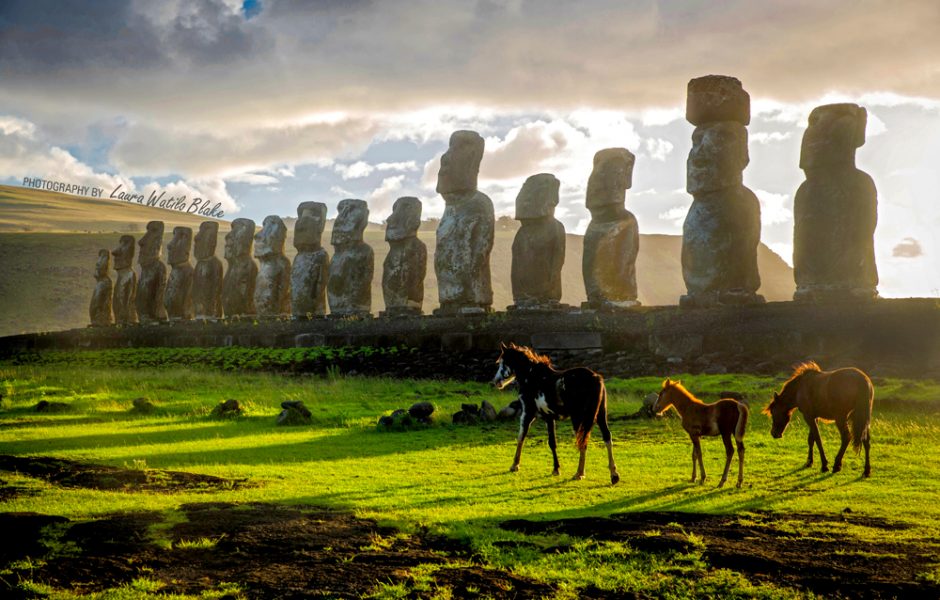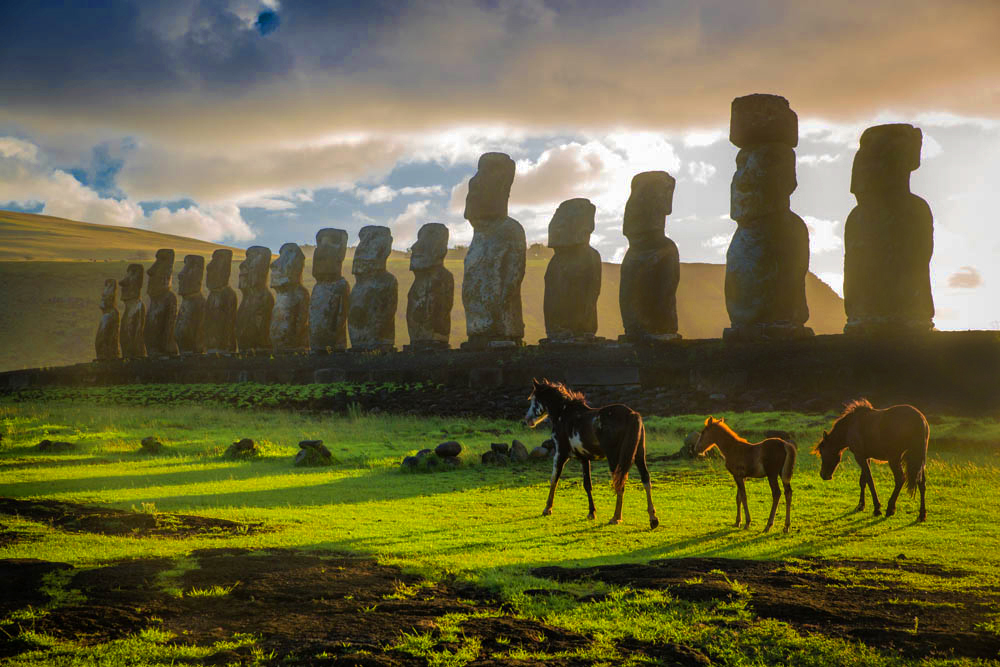Roaming Remote Easter Island

13 things you should know about the most isolated island on earth
There are few places in the world that are more magical than Easter Island, which is well known for its massive stone statues with large angular faces, known as moai. They have captured the imagination of early explorers and school-aged children worldwide for hundreds of years. But, there’s more to the island than just these rock stars. Here are a few things you might not know about island until you pay a visit to this windswept Pacific island.
Watch out for the horses. While they aren’t wild, thousands of horses have free reign of the island. Seeing a group of horses galloping on the island’s windswept terrain can be a magical moment — or extremely dangerous if you’re driving. “Keep the speed to 60 kilometer per hour,” warned the woman at Oceanic Car Rental in Hanga Roa. “Some of the roads are a bit rough, but mostly you have to keep an eye out for animals.”
The time will surprise you. Easter Island is six hours behind Greenwich Mean Time (GMT) in the winter months and -5 GMT in the summer with daylight saving time. That means, the time matches either the U.S. Central Standard Time or Eastern Standard Time depending on the season, even though it’s far off in the middle of the Pacific Ocean. That puts the sunrise close to 8 a.m. and sunset close to 9 p.m. during the island’s peak travel season in February. It was unusual to wake up in darkness and have the light linger late into the night, but it’s a huge plus for sunrise seekers, who also want to sleep in a little longer.
Wear good footwear. I wear flip-flops everywhere I go, but on Easter Island, there’s loose and uneven sharp chunks of volcanic rock everywhere that can lead to puncture wounds or a twisted ankle. The ancient inhabitants of the island apparently created “massive fields fertilised by broken volcanic rocks placed on the surface and in the ground,” according to archaeologists Terry Hunt and Carl Lipo, authors of “The Statues that Walked: Unravelling the mysteries of Easter Island.” The goal was to grow food using this lithic-mulching method, but hundreds of years later, it makes walking difficult. Even horseback riding is more challenging when the horses stumble on the rocks.
Watch your step. Besides the risk of injury, people pose a threat to archaeological artifacts scattered around the island. Out of respect for the island’s cultural history, visitors should not step on the ahu or touch the moai. Doing so can result in a prolonged stay and a huge fine. A few years ago, one Finnish tourist was jailed and fined $17,000 after chipping an ear off one of the famed moai statues.
[flagallery gid=7]
Get your park pass at the airport. Sure, you can get a pass for the national park elsewhere, but it’s really convenient to get it at the airport when you get off the plane. The fee for the national park, which includes entrance to Orongo Ceremonial Village and Rano Raraku, costs $63 for adults and $10 for children 12 and under. The ticket is valid for five days and can be used for unlimited visits during that time.
Moai are everywhere. The famous stone sculptures that encircle Easter Island number in the hundreds. Of the 887 known statues, almost half are still at Rano Raraku, the quarry where they were carved from the volcanic rock. Hundreds more “walked” upright to platforms around the perimeter of the island along prehistoric roads. Many more toppled in transport and were abandoned along the various routes where they fell. From a high vantage point at Rano Raraku, many of the fallen can be seen scattered throughout the landscape.
Watch the sunrise at Ahu Tongariki. Ahu Tongariki, which has the largest number of upright moai in one place, is one of the most magical spots on the island especially at sunrise. Many visitors will make a pre-dawn pilgrimage to the site and gather in the plaza to wait for the first rays to shine between the stone figures. By car, it takes roughly 20 minutes to get to Ahu Tongariki from Hanga Roa. In late February and early March, the sun starts to come up around 7:45 a.m.
Watch the sunset at Ahu Tahai. Located on the west side of the island, just a short walk north of town, Ahu Tahai is a gathering spot for those who want to watch the last sliver of light disappear on the horizon. The largest platform has five moai that are true rock stars and the hillside above them is the amphitheater.
The postcard stamps are ugly. Easter Island has some of the most magical scenery in the world and yet the postcard stamps lack imagery altogether; they are just plain white stickers with black type (and cost 380 pesos each for U.S. delivery). It’s a major missed opportunity for the country to highlight their cultural and archaeological assets. However, the local post office in Hanga Roa makes up for it by offering visitors a passport stamp depicting its iconic moai statues. It has no legal standing, but it’s free. The post office is open Monday to Saturday.
Wifi sucks. The internet is available most places, but it’s painfully slow. Spare yourself the frustration and don’t plan on doing anything that will use too much bandwidth.
Rent a car. It’s worth renting a car for a couple days to explore Easter Island on your own. My husband and I found that we had many sites to ourselves when we set out late in the afternoon.
You can drink the water. Easter Island has limited freshwater resources, but what they do have is drinkable thanks to a good water treatment facility. However, the local water has high levels of magnesium, which can cause stomach upset. If you’re not willing to risk it, stick to the bottled water.
Get your plane tickets early. LAN Airlines, the only commercial airlines that flies to the island, flies several times a week from Santiago or Tahiti.


Comments